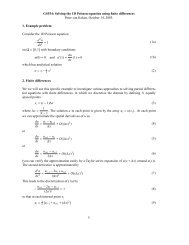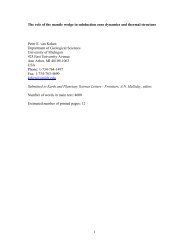Quantitative paleoenvironmental and paleoclimatic reconstruction ...
Quantitative paleoenvironmental and paleoclimatic reconstruction ...
Quantitative paleoenvironmental and paleoclimatic reconstruction ...
Create successful ePaper yourself
Turn your PDF publications into a flip-book with our unique Google optimized e-Paper software.
ARTICLE IN PRESS<br />
42 N.D. Sheldon, N.J. Tabor / Earth-Science Reviews xxx (2009) xxx–xxx<br />
Fig. 23 depicts the predicted pH values for a wide range of fractional<br />
values between a hypothetical paleosol <strong>and</strong> its parent material.<br />
Larger fractionations of δ 11 B between a paleosol <strong>and</strong> its parent<br />
material correspond to more acidic pHs. It should be noted that at<br />
lower temperatures, more typical of soil formation, more acidic pH<br />
values would be predicted for the same magnitude fraction of δ 11 B.<br />
25 °C was used primarily because it represents st<strong>and</strong>ard temperature<br />
for thermodynamic data, but it is possible to solve for values appropriate<br />
for lower temperatures, so this does not represent an impediment<br />
to applying this method.<br />
One potentially exciting application of pH values calculated from<br />
δ 11 B values of pedogenic carbonates is to address the question of what<br />
a reasonable value for S(z) is in calculations of paleoatmospheric CO 2<br />
levels (see Section 7.4.3.1), because the pH at the time of formation<br />
of the pedogenic carbonate nodules should be related to soil gas<br />
composition. For the purposes of illustration, we will consider the<br />
simplest possible case (again at 25 °C) for the formation of pedogenic<br />
carbonate:<br />
CO 2ðgÞ þ H 2 O þ Ca 2þ ¼ 2H þ þ CaCO 3 LogK calcite ¼ −9:634 ð66Þ<br />
Assuming pure calcite <strong>and</strong> water (i.e., a=1), the equilibrium<br />
relationship may be defined as follows:<br />
h i<br />
H + 2<br />
h i<br />
H + 2<br />
=KZ = pCO<br />
½pCO 2 Š Ca 2+ K 3 Ca 2+<br />
2 ð67Þ<br />
Because there is a 1:1 relationship between the number of moles<br />
of Ca 2+ <strong>and</strong> CO 2 , the expression may be further simplified to the<br />
following:<br />
Sz ðÞ= pCO 2 =<br />
sffiffiffiffiffiffiffiffiffiffiffiffiffi<br />
½a H + Š 2<br />
K calcite<br />
ð68Þ<br />
Using pH values derived from Fig. 23 for (δ ΣB −δ BA − ) values<br />
ranging from 16 to 19 gives a range of pH from 8.05 to 7.04 (aH +<br />
8.86×10 − 9 to 8.94×10 −8 ). Applying those values to Eq. (68) gives a<br />
range of S(z) values of 581–5867 ppm, with the largest δ 11 B (<strong>and</strong><br />
lowest pH) values indicating the highest S(z) as would be expected.<br />
For most calculations of paleatmospheric CO 2 levels, the predicted S(z)<br />
using this method is similar to what is already being used, though<br />
somewhat lower, as only relatively acidic pH conditions would predict<br />
high S(z). Using lower S(z) values would predict lower atmospheric<br />
CO 2 values (Section 7.4.3.1), so this is potentially important as an<br />
additional check on those calculations.<br />
Thus, there is considerable scope for development of new paleoproxies<br />
for pH <strong>and</strong> potentially for S(z) using δ 11 B analyses obtained<br />
from pedogenic carbonates. The main difficulties lie with δ 11 B analysis<br />
Fig. 23. Boron isotope fractionation versus pH for 25 °C. At lower temperatures,<br />
fractionation factors are smaller when boric acid is converted to borate (Kakihana et al.,<br />
1977), which shifts the curve to the left.<br />
itself, potentially poorly constrained parent material compositions,<br />
<strong>and</strong> uncertainties about paleotemperature at the time that the carbonate<br />
formed. Nonetheless, we feel that this is an area of research with<br />
considerable scope for future growth.<br />
8.2. Energy balance models<br />
Another recent development is a model that relates energy input<br />
into the soil system during weathering to mean annual precipitation<br />
(MAP) <strong>and</strong> temperature (MAT). Rasmussen et al. (2005) defined a<br />
new term for the energy input into a soil during pedogenesis (E in );<br />
Rasmussen <strong>and</strong> Tabor (2007) refined the early framework, renaming<br />
E in as effective energy <strong>and</strong> mass transfer (EEMT) <strong>and</strong> put forward a<br />
quantitative pedogenic energy model (QPEM) that relates EEMT to<br />
various quantitative measures of pedogenic properties including<br />
pedon depth, clay content, CIA-K (Eq. (5)), <strong>and</strong> the ratio of free Feoxides<br />
to total Fe (Fe d /Fe T ). EEMT represents the total amount of solar<br />
energy that is available for pedogenesis <strong>and</strong> is represented by two<br />
quantities: 1) heat available to warm soil material <strong>and</strong> water <strong>and</strong><br />
2) reduction of C due to photosynthesis (Rasmussen <strong>and</strong> Tabor, 2007).<br />
Full derivation of the model may be found in Rasmussen et al. (2005)<br />
<strong>and</strong> Rasmusen <strong>and</strong> Tabor (2007); at least one of the relationships<br />
in the paper is potentially applicable to paleosols. Using empirical<br />
data collected for soils with igneous parent materials in the Sierra<br />
Nevadas, southern Cascades, <strong>and</strong> Sierra San Pedro Martir ranges,<br />
EEMT (kJ m −2 yr −1 ) may be related to MAT <strong>and</strong> MAP as follows:<br />
EEMT = 347; 134 exp − 0:5 MAT − 21:5<br />
ð − 10:5 Þ 2 +<br />
MAP − 4412<br />
ð 1704 Þ 2 ð69Þ<br />
Rasmussen <strong>and</strong> Tabor (2007) also found significant differences<br />
in EEMT among different soil orders (UltisolsNAlfisols≈AndisolsN<br />
MollisolsNInceptisolsNEntisols). In the form of Eq. (69), the relationship<br />
is somewhat cumbersome to apply, because while calculation of<br />
EEMT for a paleosol where MAT <strong>and</strong> MAP are known could be used to<br />
confirm a taxonomic designation, those <strong>paleoclimatic</strong> values (in particular<br />
MAT) are not that well-constrained typically. Alternatively,<br />
Rasmussen <strong>and</strong> Tabor's (2007) relationship may be re-arranged to<br />
solve for either MAT or MAP. As an example, here is the re-arranged<br />
expression for MAT:<br />
MAT = 21:5 +<br />
qffiffiffiffiffiffiffiffiffiffiffiffiffiffiffiffiffiffiffiffiffiffiffiffiffiffiffiffiffiffiffiffiffiffiffiffiffiffiffiffiffiffiffiffiffiffiffiffiffiffiffiffiffiffiffiffiffiffiffiffiffiffiffi<br />
<br />
½ − 2Ln EEMT MAP − 4412 2<br />
347;134<br />
+<br />
1704<br />
−10:1<br />
ð70Þ<br />
To give a concrete example, we will apply Eq. (70) to a series of<br />
Miocene Alfisol-like paleosols (Argillisols; Sheldon, 2006d) used elsewhere<br />
in this review. EEMT for Alfisols is 25,875±1781 kJ m −2 yr − 1<br />
(Rasmussen <strong>and</strong> Tabor, 2007) <strong>and</strong> the reconstructed MAP using<br />
Eq. (30) ranges from 540 to 854 mm/yr. Assuming a constant EEMT<br />
<strong>and</strong> using the MAP figures published by Sheldon (2006d),MATfigures<br />
ranging from ~12 to 20 °C are obtained (Fig. 24) <strong>and</strong> are plotted<br />
against previously obtained MAT estimates using Eq. (25). Obviously,<br />
the MAT estimates obtained using EEMT are very different than those<br />
obtained using Eq. (25), so which estimate is more reasonable?<br />
Both equations have upper limits to the temperatures that they can<br />
predict, (17.3 °C for Eq. (25) <strong>and</strong> 21.5 °C for Eq. (70)), so Eq. (70) is<br />
potentially viable over a larger range of paleotemperatures than<br />
Eq. (25). The paleosols all correspond to the middle Miocene climatic<br />
optimum, which lead Sheldon (2006d) to question the paleotemperature<br />
results in his original study that used Eq. (25), because while<br />
the MAP estimates that he obtained matched paleobotanical results,<br />
the MAT values were only semi-consistent with estimates based<br />
on paleobotanical proxies for MAT (i.e., the highest MAT values<br />
with the full SE). Thus, based on independent lines of evidence the<br />
values obtained using Eq. (70) are perhaps more in line with expected<br />
middle Miocene MAT.<br />
Please cite this article as: Sheldon, N.D., Tabor, N.J., <strong>Quantitative</strong> <strong>paleoenvironmental</strong> <strong>and</strong> <strong>paleoclimatic</strong> <strong>reconstruction</strong> using paleosols, Earth-<br />
Science Reviews (2009), doi:10.1016/j.earscirev.2009.03.004















